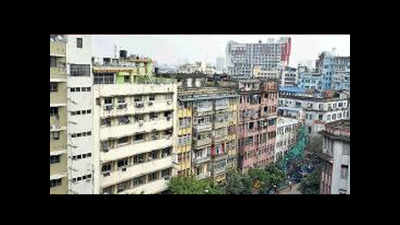- News
- City News
- kolkata News
- Wiring worry for central Kolkata tinderbox
Trending
This story is from October 18, 2020
Wiring worry for central Kolkata tinderbox
Big houses standing shoulder-to-shoulder with hardly any gap in between, one door to access the entire building with a single staircase leading to different floors, meter box crammed under the staircase, decades-old wiring and their mixed use, shops on the ground floor and residents on others: buildings in prime central Kolkata locations are not merely fire-prone, they are also death traps for residents.

The central Kolkata neighbourhood, which houses old buildings that stand cheek by jowl
KOLKATA: Big houses standing shoulder-to-shoulder with hardly any gap in between, one door to access the entire building with a single staircase leading to different floors, meter box crammed under the staircase, decades-old wiring and their mixed use, shops on the ground floor and residents on others: buildings in prime central Kolkata locations are not merely fire-prone, they are also death traps for residents.
“Most buildings in the belt that were constructed in the ’50s and ’60s are now extremely vulnerable to fire. If a fire blocks the entrance and stairway, residents get trapped. Even firemen have a tough time as they have access only from the front door,” a former additional director-general of state fire services said. The biggest problem, fire experts said, was the location of meter boxes below staircases and old electrical wiring that made them susceptible to electricity leakage and short circuit.

Fire experts said reducing the risk to life was not difficult if meter boxes were removed to the passage, isolating the main door and stairs from fire risk, the electrical load was checked, wiring was revamped and miniature circuit breakers (MCBs) were installed. Storage of inflammables in shops there should not be allowed.
People in central Kolkata said conversion of residential buildings into offices that led to installation of ACs and conversion of common spaces into cubicles has turned many old buildings into fire traps. In addition, disputes between landlords and tenants led to poor maintenance. “This is the story in every other house on Central Avenue, Ganesh Chandra Avenue, R N Mukherjee Road, Waterloo Street, British Indian Street and Meredith Street. People have converted old apartments into offices. There is no space for emergency exits or water reservoirs,” said Dilshad Hussain, secretary of a residents’ association, which is fighting a legal case with the landlord to repair the building.
Fire consultant Tarak Chakraborty said residents could fund for retrofitting of refuge areas on alternative floors and an escape staircase in the back. “Inhalation of smoke causes maximum casualty. If people can breathe fresh air, they will survive. Rescue operations also become easier for the fire brigade,” Chakraborty said.
“Most buildings in the belt that were constructed in the ’50s and ’60s are now extremely vulnerable to fire. If a fire blocks the entrance and stairway, residents get trapped. Even firemen have a tough time as they have access only from the front door,” a former additional director-general of state fire services said. The biggest problem, fire experts said, was the location of meter boxes below staircases and old electrical wiring that made them susceptible to electricity leakage and short circuit.
TimesView
Central Kolkata fires pose a unique problem because of the layout of the neighbourhoods as well as their age and nature of upkeep. Government agencies should focus on this zone and its peculiar problems and come up with solutions that can work to preempt repeats.

“In some buildings, wirings are decades old and have never been overhauled. People who own offices there are often reluctant to pay their share for the repairs,” said Sandip Jaiswal, resident of a building on Ganesh Chandra Avenue, half of which houses offices.
Fire experts said reducing the risk to life was not difficult if meter boxes were removed to the passage, isolating the main door and stairs from fire risk, the electrical load was checked, wiring was revamped and miniature circuit breakers (MCBs) were installed. Storage of inflammables in shops there should not be allowed.
People in central Kolkata said conversion of residential buildings into offices that led to installation of ACs and conversion of common spaces into cubicles has turned many old buildings into fire traps. In addition, disputes between landlords and tenants led to poor maintenance. “This is the story in every other house on Central Avenue, Ganesh Chandra Avenue, R N Mukherjee Road, Waterloo Street, British Indian Street and Meredith Street. People have converted old apartments into offices. There is no space for emergency exits or water reservoirs,” said Dilshad Hussain, secretary of a residents’ association, which is fighting a legal case with the landlord to repair the building.
Fire consultant Tarak Chakraborty said residents could fund for retrofitting of refuge areas on alternative floors and an escape staircase in the back. “Inhalation of smoke causes maximum casualty. If people can breathe fresh air, they will survive. Rescue operations also become easier for the fire brigade,” Chakraborty said.
End of Article
FOLLOW US ON SOCIAL MEDIA










